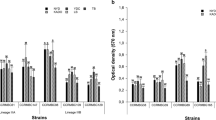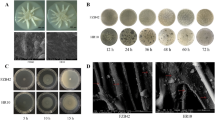Abstract
Bacterial soft rot caused by Dickeya zeae MS1 (Erwinia chrysanthemi) is one of the most devastating banana diseases worldwide. However, knowledge of the development and ecological interactions of D. zeae MS1 biofilm is limited. Here, we visualized the development and architecture of D. zeae MS1 biofilm using confocal laser scanning microscopy, and we evaluated the ability of D. zeae MS1 to form biofilms under different environmental conditions (carbon sources, temperatures, pH levels and mineral elements) using a microtiter plate assay. We found that the development of D. zeae MS1 biofilm could be categorized into four phases and that mature biofilm consisted of a highly organized architecture of both bacterial cells and a self-produced matrix of extracellular polysaccharides. Furthermore, sucrose was the most suitable carbon source for supporting the growth of biofilm cells and that 32 °C and pH 7.0 were the most favorable of the temperatures and pH levels examined. Meanwhile, the addition of Ca2+, Fe2+, K+ and Na+ enhanced the formation of biofilm in minimal medium cultures, whereas 2.5 mM Cu2+ and Mn2+ was inhibitory. A better understanding of biofilm formation under different environmental parameters will improve our knowledge of the growth kinetics of D. zeae MS1 biofilm.




Similar content being viewed by others
References
Branda SS, Vik Å, Friedman L, Kolter R (2005) Biofilms: the matrix revisited. Trends Microbiol 13:20–26
Chavant P, Martinie B, Meylheuc T, Bellon-Fontaine MN, Hebraud M (2002) Listeria monocytogenes LO28: surface physicochemical properties and ability to form biofilms at different temperatures and growth phases. Appl Environ Microbiol 68:728–737
Cobine PA, Cruz LF, Navarrete F, Duncan D, Tygart M, de La Fuente L (2013) Xylella fastidiosa differentially accumulates mineral elements in biofilm and planktonic cells. PLoS ONE 8:e54936
Cruz LF, Cobine PA, de La Fuente L (2012) Calcium increases Xylella fastidiosa surface attachment, biofilm formation, and twitching motility. Appl Environ Microbiol 78:1321–1331
Czajkowski R, Grabe GJ, van der Wolf JM (2009) Distribution of Dickeya spp. and Pectobacterium carotovorum subsp. carotovorum in naturally infected seed potatoes. Eur J Plant Pathol 125:263–275
de Campos PA, Royer S, da Fonseca BDW, Araújo BF, Queiroz LL, de Brito CS, Gontijo-Filho PP, Ribas RM (2016) Multidrug resistance related to biofilm formation in Acinetobacter baumannii and Klebsiella pneumoniae clinical strains from different pulsotypes. Curr Microbiol 72(5):617–627
Elphinstone JG (2007) The canon of potato science: bacterial pathogens. Potato Res 50:247–249
Ghods S, Sims IM, Moradali MF, Rehm BHA (2015) Bactericidal compounds controlling growth of the plant pathogen Pseudomonas syringae pv. actinidiae, which forms biofilms composed of a novel exopolysaccharide. Appl Environ Microbiol 81(12):4026–4036
Hall-Stoodley L, Costerton JW, Stoodley P (2004) Bacterial biofilms: from the natural environment to infectious diseases. Nat Rev Microbiol 2:95–108
Hoffman LR, D’Argenio DA, MacCoss MJ, Zhang Z, Jones RA, Miller SI (2005) Aminoglycoside antibiotics induce bacterial biofilm formation. Nature 436:1171–1175
Jahn CE, Selimi DA, Barak JD, Charkowski A (2011) The Dickeya dadantii biofilm matrix consists of cellulose nanofibres, and is an emergent property dependent upon the type III secretion system and the cellulose synthesis operon. Microbiology 157:2733–2744
Jin Y, Samaranayake LP, Samaranayake Y, Yip HK (2004) Biofilm formation of Candida albicans is variably affected by saliva and dietary sugars. Arch Oral Biol 49:789–798
Kapsa JS (2008) Important threats in potato production and integrated pathogen/pest management. Potato Res 51:385–401
Karatan E, Watnick P (2009) Signals, regulatory networks, and materials that build and break bacterial biofilms. Microbiol Mol Biol Rev 73:310–347
Kieu NP, Aznar A, Segond D, Rigault M, Simond-Côte E, Kunz C, Soulay F, Expert D, Dellagi A (2012) Iron deficiency affects plant defence responses and confers resistance to Dickeya dadantii and Botrytis cinerea. Mol Plant Pathol 13:816–827
Killiny N, Martinez RH, Dumenyo CK, Cooksey DA, Almeida RPP (2013) The exopolysaccharide of Xylella fastidiosa is essential for biofilm formation, plant virulence, and vector transmission. Mol Plant Microbe Interact 26:1044–1053
Koczan JM, McGrath MJ, Zhao Y, Sundin GW (2009) Contribution of Erwinia amylovora exopolysaccharides amylovoran and levan to biofilm formation: implications in pathogenicity. Phytopathology 99:1237–1244
Laurila J, Hannukkala A, Nykyri J, Pasanen M, Hélias V, Garlant L, Pirhonen M (2010) Symptoms and yield reduction caused by Dickeya spp. strains isolated from potato and river water in Finland. Eur J Plant Pathol 126:249–262
Lin BR, Shen HF, Pu XM, Tian XS, Zhao WJ, Zhu SF, Dong MM (2010) First report of a soft rot of banana in mainland China caused by a Dickeya sp. (Pectobacterium chrysanthemi). Plant Dis 94:640
Martinez LR, Casadevall A (2007) Cryptococcus neoformans biofilm formation depends on surface support and carbon source and reduces fungal cell susceptibility to heat, cold, and UV light. Appl Environ Microbiol 73:4592–4601
Murugan K, Selvanayaki K, Al-Sohaibani S (2016) Urinary catheter indwelling clinical pathogen biofilm formation, exopolysaccharide characterization and their growth influencing parameters. Saudi J Biol Sci 23:150–159
Navarrete F, de La Fuente L (2014) Response of Xylella fastidiosa to zinc: decreased culturability, increased exopolysaccharide production, and formation of resilient biofilms under flow conditions. Appl Environ Microbiol 80:1097–1107
Palacio-Bielsa A, Mosquera MER, Álvarez MAC, Rodríguez IMB, López-Solanilla E, Rodríguez-Palenzuela P (2010) Phenotypic diversity, host range and molecular phylogeny of Dickeya isolates from Spain. Eur J Plant Pathol 127:311–324
Prigent-Combaret C, Zghidi-Abouzid O, Effantin G, Lejeune P, Reverchon S, Nasser W (2012) The nucleoid-associated protein Fis directly modulates the synthesis of cellulose, an essential component of pellicle–biofilms in the phytopathogenic bacterium Dickeya dadantii. Mol Microbiol 86:172–186
Rinaudi L, Fujishige NA, Hirsch AM, Banchio E, Zorreguieta A, Giordano W (2006) Effects of nutritional and environmental conditions on Sinorhizobium meliloti biofilm formation. Res Microbiol 157:867–875
Rodrigues CM, Takita MA, Coletta-Filho HD, Olivato JC, Caserta R, Machado MA, de Souza AA (2008) Copper resistance of biofilm cells of the plant pathogen Xylella fastidiosa. Appl Microbiol Biotechnol 77:1145–1157
Shriner AD, Andersen PC (2014) Effect of oxygen on the growth and biofilm formation of Xylella fastidiosa in liquid media. Curr Microbiol 69:866–873
Stepanović S, Vuković D, Dakić I, Savić B, Švabić-Vlahović M (2000) A modified microtiter-plate test for quantification of Staphylococcal biofilm formation. J Microbiol Methods 40:175–179
Teh AH, Lee SM, Dykes GA (2016) The influence of prior modes of growth, temperature, medium, and substrate surface on biofilm formation by antibiotic-resistant Campylobacter jejuni. Curr Microbiol 73:859–866
Tsror L, Erlich O, Lebiush S, Hazanovsky M, Zig U, Slawiak M (2009) Assessment of recent outbreaks of Dickeya sp. (syn. Erwinia chrysanthemi) slow wilt in potato crops in Israel. Eur J Plant Pathol 123:311–320
Vinod KK, Lall C, Vimal RR, Vedhagiri K, Sunish IP, Vijayachari P (2016) In vitro antimicrobial susceptibility of pathogenic Leptospira biofilm. Microb Drug Resist 22(7):511–514
Wu PH, Huang DD, Chang DCN (2011) Mycorrhizal symbiosis enhances Phalaenopsis orchid’s growth and resistance to Erwinia chrysanthemi. Afr J Biotechnol 10:10095–10100
Xu Z, Liang Y, Lin S, Chen D, Li B, Li L, Deng Y (2016) Crystal violet and XTT assays on Staphylococcus aureus biofilm quantification. Curr Microbiol 73(4):1–9
Yaganza ES, Tweddell RJ, Arul J (2014) Postharvest application of organic and inorganic salts to control potato (Solanum tuberosum L.) storage soft rot: plant tissue-salt physicochemical interactions. J Agric Food Chem 62:9223–9231
Yuan J, Chen Y, Zhou G, Chen H, Gao H (2013) Investigation of roles of divalent cations in Shewanella oneidensis pellicle formation reveals unique impacts of insoluble iron. Biochim Biophys Acta 1830:5248–5257
Zaini PA, Fogaça AC, Lupo FG, Nakaya HI, Vêncio RZ, da Silva AM (2008) The iron stimulon of Xylella fastidiosa includes genes for type IV pilus and colicin V-like bacteriocins. J Bacteriol 190:2368–2378
Zhang J, Shen H, Pu X, Lin B, Hu J (2014) Identification of Dickeya zeae as a causal agent of banana soft rot in banana in China. Plant Dis 98:436–442
Zhang JX, Lin BR, Shen HF, Pu XM (2013) Genome Sequence of the banana pathogen Dickeya zeae strain MS1, which caused bacterial soft rot. Genome Announc 1:e00317–e00313
Acknowledgements
We would like to thank Dr. Aiping Xu (Public Monitoring Center for Agro-product of Guangdong Academy of Agricultural Science, Guangdong, Guangzhou) and Weina Zhang (Centre for Agrobiological Gene Research, Guangdong Academy of Agricultural Sciences, Guangdong, Guangzhou) for their assistance with confocal laser scanning microscopy.
Funding
This work was supported by the Natural Science Foundation of Guangdong Province (No. 2015A030312002); the Guangzhou Science and Technology Project (No. 2014J4500034); the President Foundation of the Guangdong Academy of Agricultural Sciences (No. 201515).
Author information
Authors and Affiliations
Corresponding author
Ethics declarations
Conflict of interest
None declared.
Rights and permissions
About this article
Cite this article
Huang, N., Pu, X., Zhang, J. et al. In Vitro Formation of Dickeya zeae MS1 Biofilm. Curr Microbiol 76, 100–107 (2019). https://doi.org/10.1007/s00284-018-1593-y
Received:
Accepted:
Published:
Issue Date:
DOI: https://doi.org/10.1007/s00284-018-1593-y




